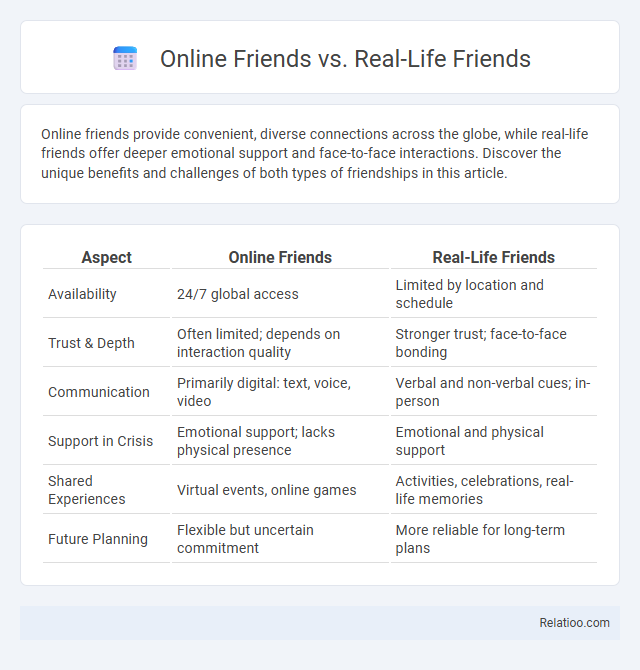Online friends provide convenient, diverse connections across the globe, while real-life friends offer deeper emotional support and face-to-face interactions. Discover the unique benefits and challenges of both types of friendships in this article.
Table of Comparison
| Aspect | Online Friends | Real-Life Friends |
|---|---|---|
| Availability | 24/7 global access | Limited by location and schedule |
| Trust & Depth | Often limited; depends on interaction quality | Stronger trust; face-to-face bonding |
| Communication | Primarily digital: text, voice, video | Verbal and non-verbal cues; in-person |
| Support in Crisis | Emotional support; lacks physical presence | Emotional and physical support |
| Shared Experiences | Virtual events, online games | Activities, celebrations, real-life memories |
| Future Planning | Flexible but uncertain commitment | More reliable for long-term plans |
Understanding Online Friendships
Online friendships often rely on consistent digital communication and shared virtual experiences, fostering emotional connections that can be as meaningful as in-person interactions. Real-life friends benefit from physical presence, nonverbal cues, and spontaneous social activities, strengthening bonds through face-to-face engagement. Understanding online friendships requires recognizing the unique ways trust, empathy, and support are built through text, video calls, and social media, highlighting their legitimacy alongside traditional friendships.
Defining Real-Life Friendships
Real-life friendships are characterized by face-to-face interactions, shared experiences, and physical presence, fostering deeper emotional bonds and trust. These relationships often involve nonverbal communication cues and spontaneous activities that enhance connection and understanding. Compared to online friendships, real-life friendships provide tangible support and a stronger sense of reliability rooted in everyday social contexts.
Communication Styles: Digital vs Face-to-Face
Online friends often rely on text-based communication, emojis, and video calls, which can sometimes lead to misunderstandings or a lack of emotional depth compared to face-to-face interactions. Real-life friends benefit from nonverbal cues like body language, tone of voice, and immediate feedback that enhance trust and empathy in the friendship. Your communication style shapes the quality of your relationships, highlighting the importance of balancing digital and in-person interactions for meaningful connections.
Emotional Support: Virtual vs Physical Presence
Emotional support from real-life friends often benefits from physical presence, enabling nonverbal cues and immediate comfort that strengthen bonds. Online friends provide valuable emotional support through constant connectivity and shared experiences in virtual spaces, fostering empathy despite geographic separation. Balancing both types of friendships enhances emotional well-being by combining in-person interactions with accessible digital support networks.
Trust and Authenticity in Friendships
Trust and authenticity form the foundation of genuine friendships, whether online or in real life. Your online friends can provide support and connection through digital interactions, but building deep trust often requires face-to-face experiences where nonverbal cues enhance understanding. Real-life friendships typically offer more consistent opportunities for authenticity, fostering stronger emotional bonds and reliable support systems.
Building Deeper Connections: Online vs Offline
Building deeper connections online often depends on consistent communication through video calls and interactive platforms, which can transcend geographical barriers and foster emotional intimacy. Offline friendships benefit from shared physical experiences and nonverbal cues, which enhance trust and empathy more naturally. Balancing both online and real-life interactions can create a richer, more resilient friendship by combining accessibility with authenticity.
Challenges in Maintaining Online and Real-Life Friendships
Maintaining online friendships often faces challenges such as limited nonverbal cues and time zone differences, which can hinder emotional connection and spontaneous interactions. Real-life friendships require consistent physical presence and shared experiences, making distance and busy schedules significant obstacles to sustaining strong bonds. Both types of friendship demand effort in communication and trust-building to overcome misunderstandings and maintain meaningful relationships over time.
Effects of Technology on Social Relationships
Technology has transformed social relationships by enabling online friends to offer continuous connectivity and diverse interactions beyond geographical limits, often enriching your social network with varied perspectives. However, real-life friends tend to provide deeper emotional support and non-verbal communication that technology cannot fully replicate, fostering stronger trust and empathy in face-to-face settings. The rise of digital platforms has blurred boundaries between online and offline friendships, reshaping how individuals maintain connections and experience companionship in today's interconnected world.
Blurring the Lines: When Online Friends Become Real-Life Friends
The lines between online friends and real-life friends blur as digital interactions foster deep emotional connections and trust, transforming virtual relationships into meaningful, face-to-face friendships. Social media platforms, gaming communities, and messaging apps enable you to build authentic bonds that often rival traditional friendships in support and shared experiences. This convergence highlights the evolving nature of friendship, where geographic boundaries no longer limit the depth and quality of social connections.
Choosing Between Online and Real-Life Friendships
Choosing between online friends and real-life friends often depends on the quality of connection and shared experiences you value most. Real-life friendships typically offer tangible emotional support and face-to-face interaction, which strengthens trust and understanding. Online friendships provide accessibility and diverse perspectives but may lack the depth found in in-person relationships, making it important to balance both for a fulfilling social experience.

Infographic: Online Friends vs Real-Life Friends
 relatioo.com
relatioo.com